|
|
| |
| |
 |
DARLINGE PROGRESS
The DARLINGe project (DANUBE REGION LEADING GEOTHERMAL ENERGY) is approaching soon to its first year, and since its start made significant progress, especially on the state-of-art analyses (WP5) of the entire project area assessing the geothermal potential, the current use of thermal waters, the heat demand aspects of the region, as well as the existing regulatory and financial framework in the partner countries.
|
|
 |
Identification, ranking and characterization of the potential geothermal reservoirs in the project area
|
|
Geothermal reservoirs (hot and permeable subsurface rock units that store thermal water to be extracted to the surface) have regional extension and are often cut by country borders. To be able to identify, delineate and characterize these reservoirs, partners had to create joint and harmonized geological and geothermal maps and models for the entire project area, covering territories from six countries. This work required massive data gathering and joint interpretation assisted by expert discussions. The huge heterogeneity and insufficient data density for large areas was a real challenge. Nevertheless the experts managed to create uniform maps showing the geology of the most important horizons in the subsurface (top and bottom of the main geothermal aquifers) as well as temperature distributions in the depth. The delineation of the reservoirs is ongoing by the combination of these maps and the firs results will be published in January 2018.
|
|
 |
|
Depth of the 50C isotherm (m below the surface)
|
|
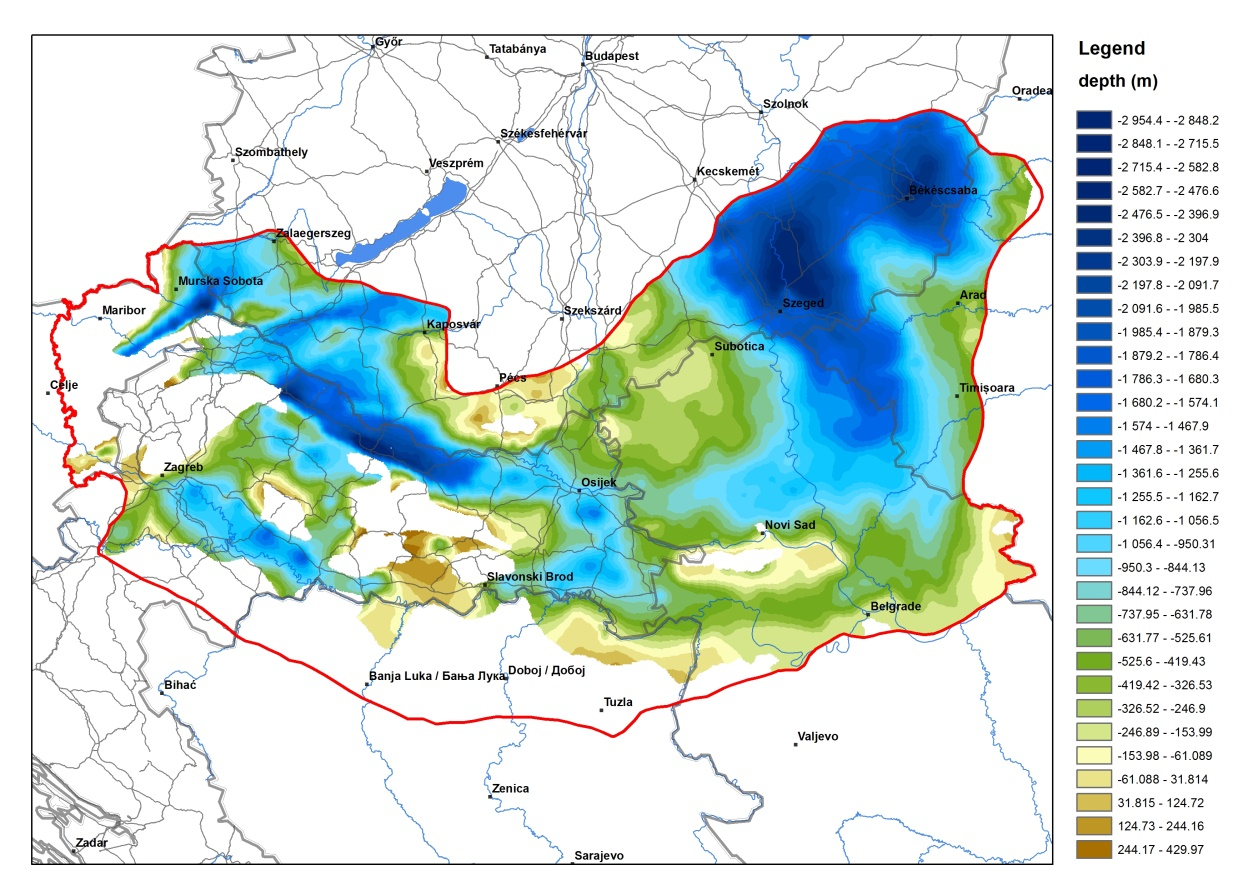 |
|
Depth of the pre-cenozoic basement (m below the surface)
|
|
| |
 Current status of geothermal water uses Current status of geothermal water uses |
| |
Altogether 766 operating thermal water wells were identified in the project area with a great diversity in their territorial distribution (608 in Hungary, 55 in Romania, 44 in Slovenia, 27 in Croatia, 20 in Serbia and 12 in Bosnia and Herzegovina). In order to make a detailed assessment of the current utilization practices, a sophisticated template was created with the aim to gather as many information as possible about these wells, including their location, drilling depths, number of screened intervals and their depths, type of utilization, water temperature and yield, reinjection parameters, produced amount of water (as reported to the National Authority in the reference year 2015) etc. Data processing and evaluation is ongoing and the final report is expected to be published in early 2018. Nevertheless there are already some interesting preliminary results, e.g. it was shown that about 50% of the wells are more than 40 years old representing a high maintenance risk; water from 50% of the wells have outflow temperature higher than 50°C indicating a high geothermal potential; more than 26% of the wells are used for heating, showing that proven practices exist.
|
 |
|
Location of thermal water wells in the project area (status as of October 2017). Light green areas represent the 3 cross-border pilot areas, where more detailed assessment will be done in 2018.
|
|
|
 Case studies on good practices Case studies on good practices
|
| From the numerous existing thermal water utilisation sites, partners have identified cases of good use of geothermal energy in each country, altogether at 13 locations. These “good practices” were described in a uniform way: characterizing the aquifer type (geological formation, depth and temperature of geothermal water), utilization type, type of cascade systems, information about reinjection etc. Examples include Szeged, Mórahalom and Szentlőrinc (Hungary), Bošnjaci and Mladost sport centre in Zagreb (Croatia), Lendava and Moravske Toplice (Slovenia), Dorobanți (Romania), Domeljevac, Gračanica and Gradačac (Bosnia and Herzegovina), Bogatic and Bačka Kanjiža (Serbia). The case studies were selected in a way that they represent the most possible wide spectrum of utilization (greenhouse heating, district heating, individual space heating, domestic hot water supply, balneology, extraction of CO2, in several cases arranged in cascaded systems), discharging different reservoirs (porous basin fill sediments, as well as fractured basement carbonates and metamorphic rocks). Where existent, bottlenecks hampering the proper use of geothermal energy were also identified. |
|
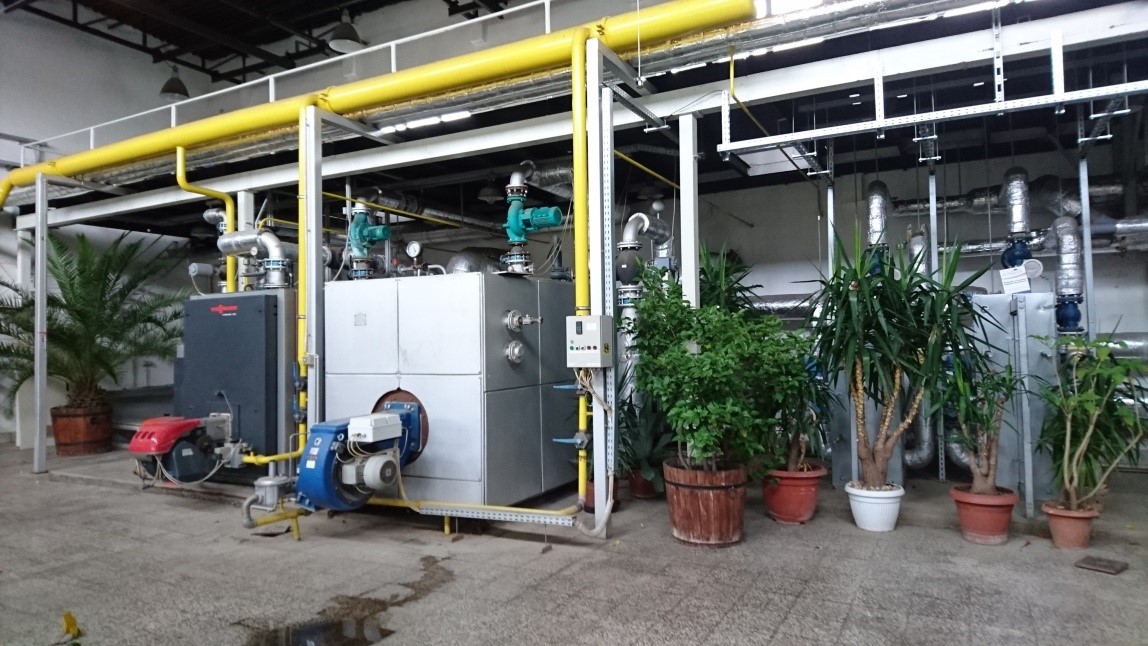 |
| |
|
Geothermal district heating system, heat centre, Szentlőrinc, Hungary
|
|
| |
 |
Heat sector analysis
|
| |
|
Partners from every project country contributed to a common report regarding the heat sector analysis at national, regional (covering the project area) and at local levels targeting some municipalities that encourage the use of geothermal energy. Local level studies included detailed energetic and economic calculations as well.
The professional heat market analyses will assist technical and political decisions and help the penetration of energy efficient geothermal systems by matching subsurface potential with existing heat market demands. The summary report will be published in January 2018.
|
|
| |
 |
Regulatory framework
|
| |
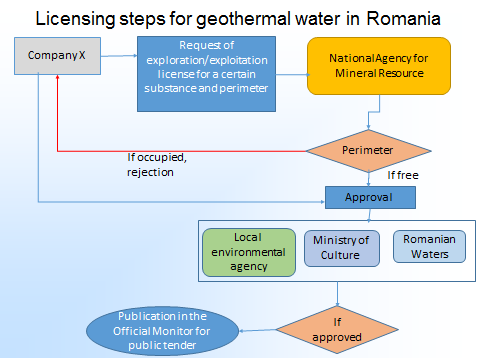 |
|
The six project partner countries have different and sometimes very complex schemes of exploration and exploitation licenses for geothermal projects. For potential investors, it is important to provide a simple overview in the form of summary flow charts with explanations regarding the procedural steps. The compilation of such flow charts and explanations showing the situation in each partner country was a main result achieved during the last period.
|
|
|
In addition, a summary report was also compiled on the most relevant and updated EU Directives regarding water, energy and renewable resources together with the key EU policies (Energy roadmaps 2013 and 2050, SET Plan etc.).
|
|
| |
 |
Evaluation of financial support mechanisms and best practice financial models for geothermal
|
| |
|
It is well known from many studies that geothermal projects are capital intensive and risky operations, and without proper financial support they are hardly competitive. DARLINGe also aimed to highlight the economic aspects of geothermal projects, with a special focus on the drilling capital, the most expensive part of such investments. In the autumn of 2017 a comprehensive report was produced that describes the different types of financial support instruments applied for direct use geothermal projects worldwide [direct investment subsidies or funds; low interest loans; tax incentives (e.g. VAT reduction), off-take-tariff for green heat energy (excluding electricity); risk insurance system (for geological/drilling risks)]. Based on a questionnaire survey the analysis performed in DARLINGe project countries revealed that only direct investment subsidies and low interest loans are available in this region, and only for a rather small amount of projects. The report also introduces some good examples from other European countries (The Netherlands, France, Iceland, Germany and Switzerland). It was concluded that only those countries could reach significant progress in deep geothermal energy utilization which were able to (1) mitigate the resource risk and (2) compensate the high up-front costs. The only practically working way of resource risk mitigation is to establish a state-owned fund. The support measures have to be constructed in a way to motivate project developers and operators. Thus, a certain ratio of own contribution and own risk have to be left at the project owner in every case.
|
|
 |
| Variation of cumulated cost and risk level of large geothermal projects (Source: Sigurður Lárus Hólm, Mannvit Kft.) |
|
| |
 |
Progress on conceptual database model
|
| |
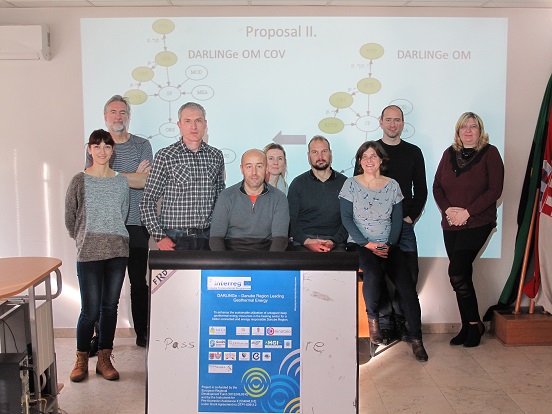 |
|
The Danube Region Geothermal Information Platform (DRGIP), a web-based interactive portal will be a joint and harmonized entry point for all spatially referenced information collected and evaluated during the project. The portal to be developed in the second half of the project is based on common database that structure and functionalities are under development and were discussed at an expert meeting held in Zagreb (28 November, 2017).
|
|
| |
 |
DARLINGE PRESENCE AT INTERNATIONAL EVENTS
|
| |
|
During the second semester DARLINGe was present at the following events:
-The 14th Steering Group Meeting of Priority Axis 2 (PA2) of the Danube Strategy, at the Institute for Foreign Affairs and Trade, Budapest, 13th July 2017
-The 44th Congress of the International Association of Hydrologists (IAH), in Dubrovnik, Croatia, 25-29 September 2017
DARLINGe had 4 oral presentations at the conference:
- Annamária Nádor, Ágnes Rotár-Szalkai, Teodóra Szőcs, Nóra Gál, Tamara Marković, Andrej Lapanje, Nina Rman, Bojan Vogrinčič, Dejan Milenić, Natalija Samardžić, Boban Jolović, Anca Vîjdea: Towards a more efficient and sustainable use of deep geothermal energy resources in the S-ern part of the Pannonian Basin, Central Europe – the DARLINGe project perspective.
- Ágnes Rotár-Szalkai, Annamária Nádor, Gyula Maros, László Zilahi-Sebess, Teodóra Szőcs, Tamara Marković, Andrej Lapanje, Nina Rman, Ana Vrajnes, Dejan Milenić, Natalija Samardžić, Boban Jolović, Radu Farnoaga, István Oláh: Delineation and characterization of geothermal reservoirs in the Southern part of the Pannonian Basin.
- Tamara Marković, Dragana Šolaja, Ivana Bobovečki, Filip Šostarić, Damir Strejček, Željka Brkić, Ozren Larva, Mario Dolić, Nataša Pomper, Staša Borović, Ana-Maria Đumbir, Nataša Hlaban, Karolina Barilar, Ivana Šalković, Ksenija Frbežar, Mladen Kuhta: Geothermal potentional of Krapisnko – Zagorska County – Croatia.
- Nina Rman, Andrej Lapanje, Teodóra Szőcs, Tamara Marković, Polona Vreča, Tjaša Kanduč, Peter Junež: Use of isotopes in exploration of mineral and thermal waters – examples from Slovenia.
|
|
| |
- 6th Annual Forum of the EU Strategy for the Danube Region
|
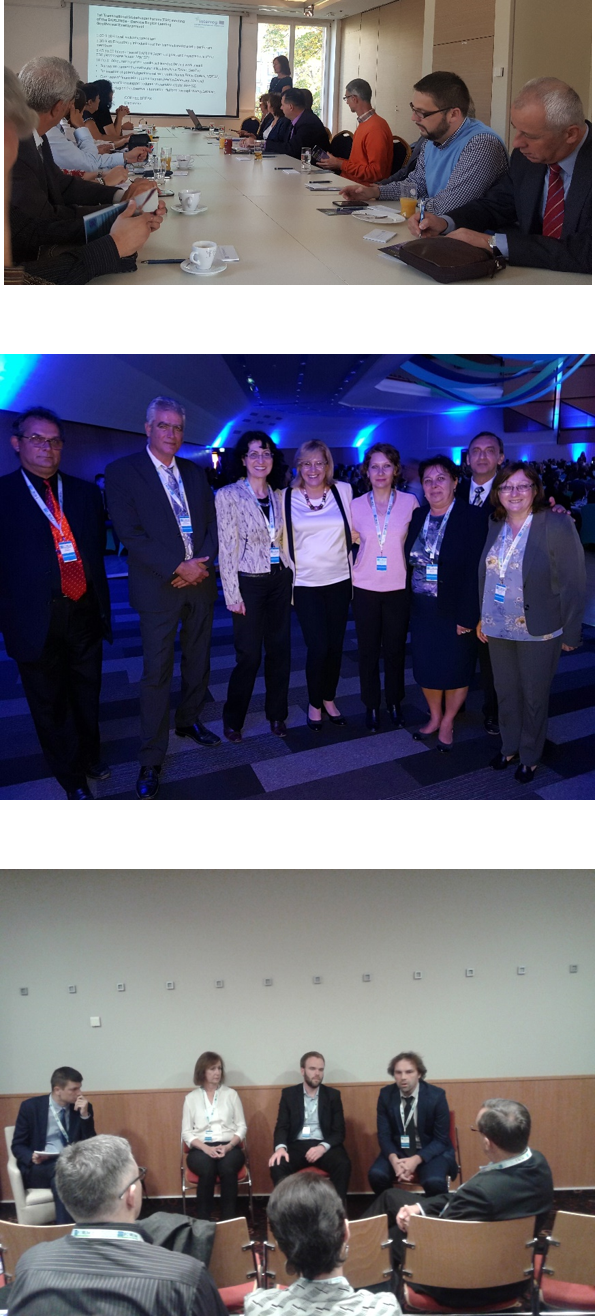
DARLINGe project had a stand at the 6th Annual Forum of the EU Strategy for the Danube Region, which took place in Budapest, on 18-19th October. As a side event of the Forum, the first Transnational Stakeholders Forum (TSF) of the DARLINGe project was organized on October 18. This was an occasion for the selected key stakeholders to personally meet each other and the project partners, to be informed about the project progress (upper figure) and also to participate at the 6th Annual Forum co-organized by the Danube Transnational Programme (DTP).
Central figure shows the European Commissioner for Regional Policy, Mrs. Corina Crețu together with members of the Romanian DARLINGe team, the representative of the Romanian Associated Strategic Partner, and the Romanian key stakeholders.
On October 19, a workshop of Thematic Pole 8 (a cluster of projects co-financed in the 1st Call of the DTP, Priority “Better connected and energy responsible Danube region” was organized with the aim to reinforce the influence of sustainable energy community to the EU Strategy for the Danube Region. TP8 has 3 projects on board at the moment: Energy Barge, 3Smart and DARLINGe (the latter being the lead of TP8). The workshop, moderated by Mr Pál Ságvári, PAC of PA2, had more than 40 attendants. The 3 projects were briefly introduced by the project leaders and than synergies, common goals and future joint activites were discussed (lower figure).
|
| |
 |
FUTURE ACTIVITIES
|
|
In 2018 DARLINGe will focus on the SWOT analysis of the state-of-art studies that will provide inputs to the Transnational Danube Region Geothermal Strategy to be drafted in the spring. Parallel with this action we shall start to develop the various tools (decision tree, benchmarking, risk-mitigation) that will be tested at the pilot areas from the fall 2018.
|
|
| |
| |
We wish to all our partners, stakeholders and people interested in our results a Merry Christmas and a very happy and prosperous New Year!
|
| |
|
|
|
|
| |
|
If you have received this newsletter, you have been included on one or more of the Danube Transnational Programme/projects postal mailing lists. We are committed to respect and protect the privacy of personal data collected. We regard your personal data as confidential information and will never communicate it to third parties. Your personal data are used mainly for the express purpose of receiving the newsletter. Your mailing details may also be used by the DTP and its projects for information and dissemination purposes strictly related to the programme and its projects. If you prefer not to receive more of this newsletter and your data not to be used for dissemination purposes, you can unsubscribe by sending a reply email.
|
|
|
|
|
|
